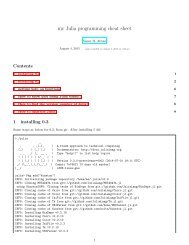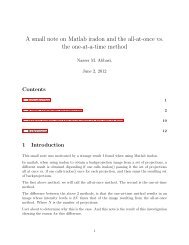You also want an ePaper? Increase the reach of your titles
YUMPU automatically turns print PDFs into web optimized ePapers that Google loves.
7 Some common formulas<br />
These definitions are used throughout the derivations below.<br />
ξ = c c r<br />
=<br />
c<br />
2 √ km = c<br />
2ω n m<br />
u st = F static deflection<br />
√<br />
k<br />
k<br />
ω n =<br />
m<br />
ω D = ω n<br />
√<br />
1 − ξ 2 note: not defined for ξ > 1 since becomes complex<br />
r = ϖ ω n<br />
T d = 2π damped period of oscillation<br />
ω<br />
{ d<br />
−1<br />
τ = , −1 }<br />
time constants where λ i are roots of characteristic equation<br />
λ 1 λ2<br />
1<br />
β =<br />
magnification factor<br />
√(1 − r 2 ) 2 + (2rξ) 2<br />
β max when r = √ 1 − 2ξ 2<br />
1<br />
β max =<br />
2ξ √ 1 − ξ 2<br />
y n<br />
= e ζωn2π<br />
ω D<br />
y<br />
( n+1<br />
)<br />
yn<br />
ln = ζ2π<br />
y n+1<br />
( )<br />
1<br />
M ln yn<br />
= ζ2π<br />
y n+M<br />
small damping<br />
⇒<br />
√<br />
ζ2π<br />
1−ζ 2<br />
e<br />
⇒ e ζ2π<br />
This table shows many cycles it takes for the peak to decay by half its original value as a function of the<br />
damping ζ. For example, we see that when ζ = 2.7% then it takes 4 cycles for the peak (i.e. displacement) to<br />
reduce to half its value.<br />
data = Table[{i, (1/i Log[2]/(2*Pi)*100)}, {i, 1, 20}];<br />
TableForm[N@data,<br />
TableHeadings -> {None, {Column[{"number of cycles",<br />
"needed for peak", "to decay by half"}], "\[Zeta] (%)"}}]<br />
31





